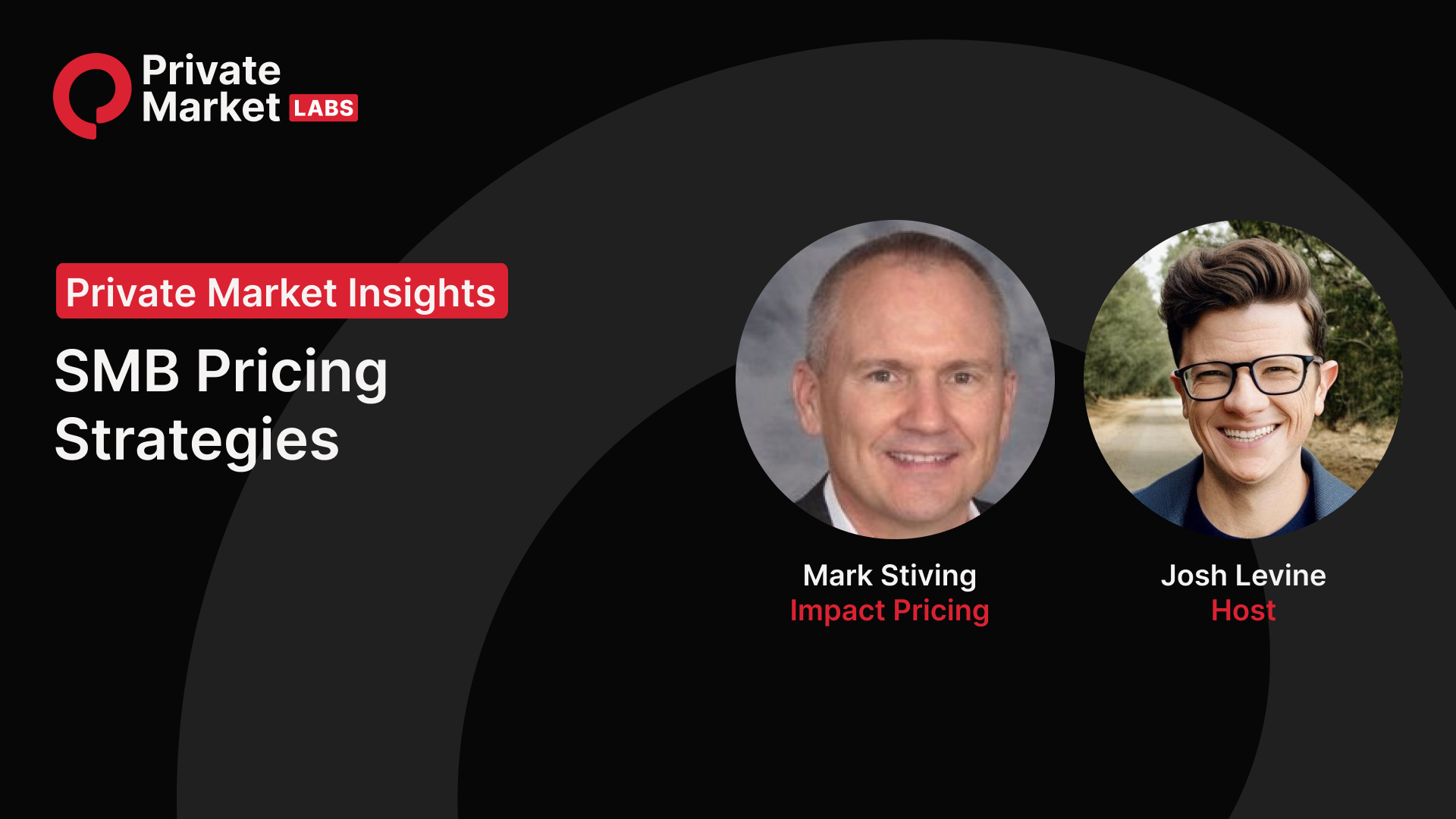In this episode of Private Market Insights, we interview pricing expert Mark Stiving, a widely recognized authority in the field with over 25 years of experience in price segmentation, pricing product portfolios, and visionary pricing. Mark shares his insights on the pricing strategies for small and medium businesses, revealing how intelligent pricing can significantly boost profitability. He explains why many people are afraid to raise prices and offers guidance on how to intelligently increase profitability through pricing.
The conversation expands on the concept of value and how it should be the focus when determining pricing. Mark also discusses price segmentation, the impact of inflation on pricing, the long-term viability of predatory pricing strategies, and the current pricing environment in the SMB acquisitions space. Below, we summarize the main topics discussed by Josh and Mark; as usual, listening to the full episode is important for understanding the nuance of the conversation.
“The only thing is, when you raise prices, you increase profitability dramatically. And if you do it intelligently, bad things might happen a little. But the slight pain you get from the little bit of bad is far outweighed by the additional profit you’re about to make.”
Mark Stiving
Value is Your North Star
Effective pricing hinges on understanding the actual value delivered to customers from a given product or service. Mark uses value tables to break pricing dynamics into solution, problem, result, and value. In B2B, value is measured in incremental profit, but most companies struggle to articulate the value they provide, leading to underpriced products. Mark encourages businesses to better understand and communicate the value they offer by systematically thinking through problems, results, and dollar values.
The Two Key Questions Faced by Every Buyer
Buyers ask two key questions: ‘Will I buy this?’ and ‘Which one will I buy?’. Price competitiveness can be crucial in the ‘Which one’ decision but is less important in the initial ‘Will I’ decision. Mark advises businesses to understand their differentiators and articulate them effectively to customers. He also points out that there are times when buyers only make a “Will I” decision, for instance, when they rely on referrals or trust an existing vendor for additional services. In these cases, businesses can potentially charge higher prices without facing competition.
How Buyers Think About Getting a “Deal”
Buyers often focus on relative costs, influenced by behavioral economics. While value should drive decisions, these perceptions can impact transactions. Mark suggests that companies should focus primarily on value and use behavioral economics and sales tactics to put the finishing touch on the end of the process. He also notes that buyers may feel cheated if they discover they paid more than others, even if the product or service provided value.
Behavioral Economics and the 99 Cent Problem
Mark discusses the “cost of thinking,” where people use quick heuristics to simplify decisions. He explains that people naturally try to avoid thinking too much when they don’t have to, and that companies can take advantage of this mental “energy conservation” in their pricing. For example, Mark applies this concept to price endings, such as $2.99, which he studied in his dissertation. He found that prices ending in 9 cents work because people are lazy and subtract from the left digits, perceiving $2.99 as a better deal than $3.00, even though the difference is marginal.
The Challenge with Articulating Value
“One of the biggest problems that most companies have at articulating value is they don’t really understand the problems they solve for their customers, the way the customers perceive it,” says Mark. This is due to the “curse of knowledge”—forgetting what it’s like not to know their product intimately. To overcome this, businesses must think from the customer’s perspective and systematically work through the problems, results, and value their products provide. Mark notes that bringing in someone new to the business (such as with an acquisition), can therefore be beneficial for companies.
The Three Ways to Grow Profit as a Function of Value
B2B profit grows through increased revenue, decreased cost, or reduced risk. Mark explains that revenue growth is often the most significant factor, followed by reduced cost, which is also tangible and believable for customers. Reduced risk, while valuable, is the most challenging to sell, as it is essentially selling insurance. Mark suggests prioritizing revenue growth and cost reduction, reframing risk reduction as cost savings.
How Quickly Should You Raise Prices Post-Close
Mark advises new owners to consider immediate price increases, noting that people within the business are likely terrified to raise prices. However, he recommends a strategic approach. By focusing on a specific market segment and building a product hierarchy around it, businesses can effectively implement price segmentation and charge different prices to customers with varying willingness to pay.
Pricing Businesses
Pricing businesses is akin to pricing products—specific buyers may pay premiums based on unique preferences or circumstances. If a seller of a business cannot find that one perfect buyer, they may need to lower the price to attract a broader range of buyers. Ultimately, it comes down to understanding the differentiation, the buyer, and what they care about.
The Prisoner’s Dilemma of Pricing
Inflation has spurred necessary price hikes. Mark advocates for an annual plan to consistently raise prices. Mark suggests that companies test price increases in competitive markets and announce them to trade publications. If competitors follow suit, it benefits everyone. However, if a competitor raises prices, other companies should follow, as the goal is to increase profits rather than market share. This creates a “reverse prisoner’s dilemma,” where continuous cooperation leads to better outcomes for all players.
“If you’re in a competitive marketplace, try testing a price increase. And by the way, announce it to the world,” says Mark.

